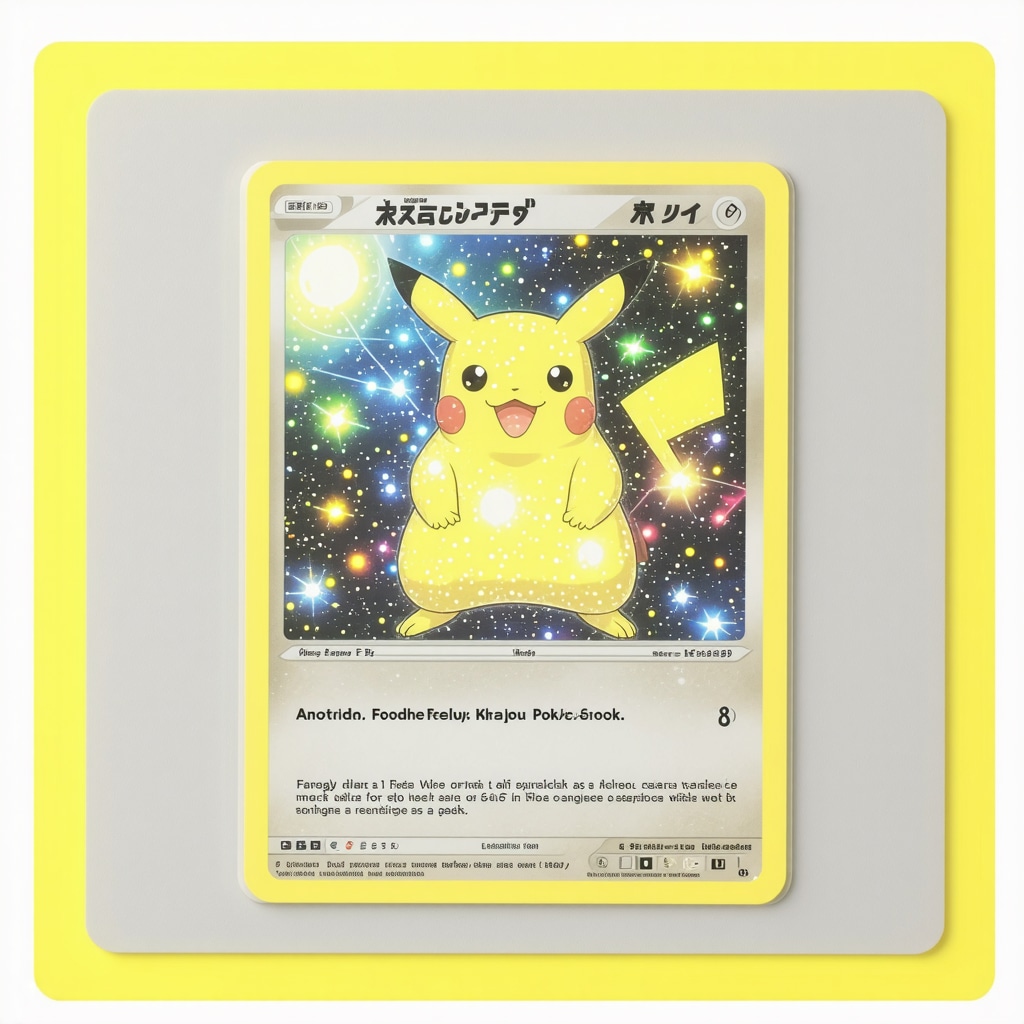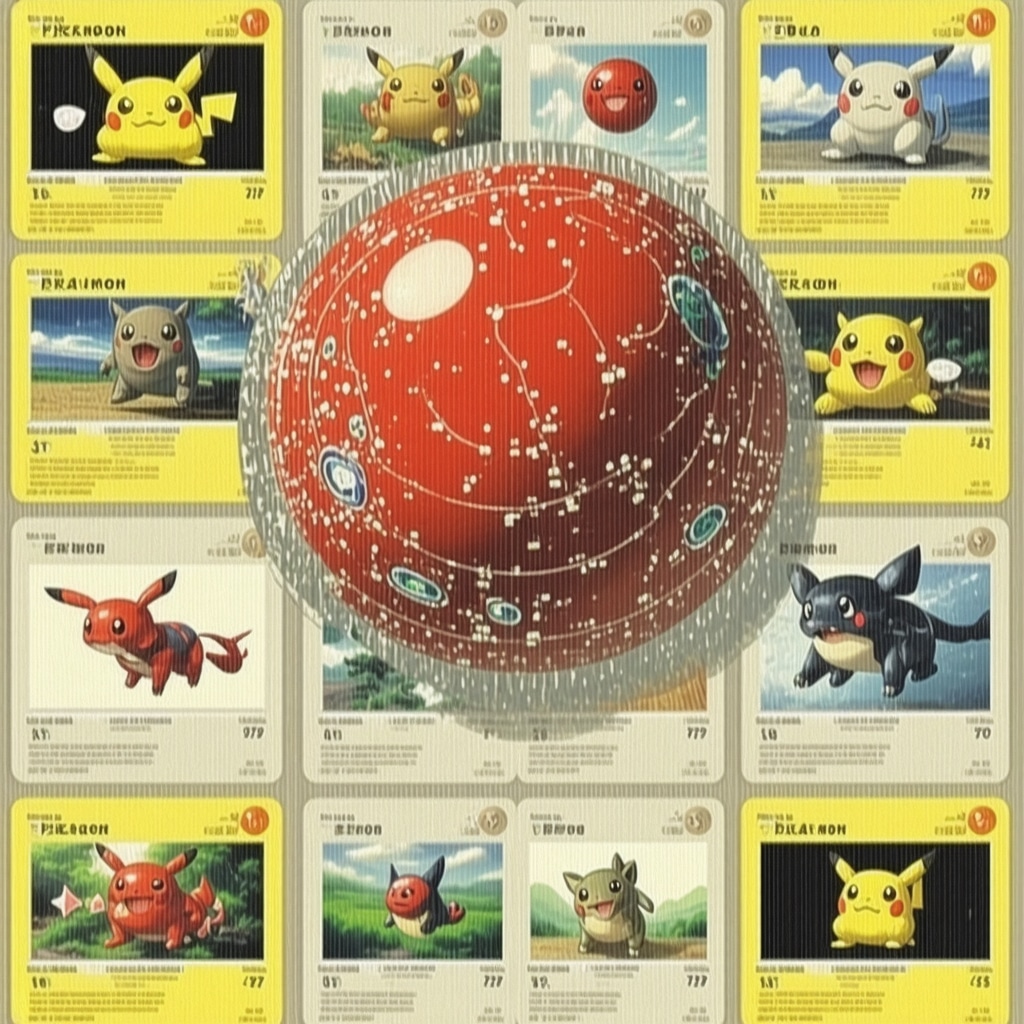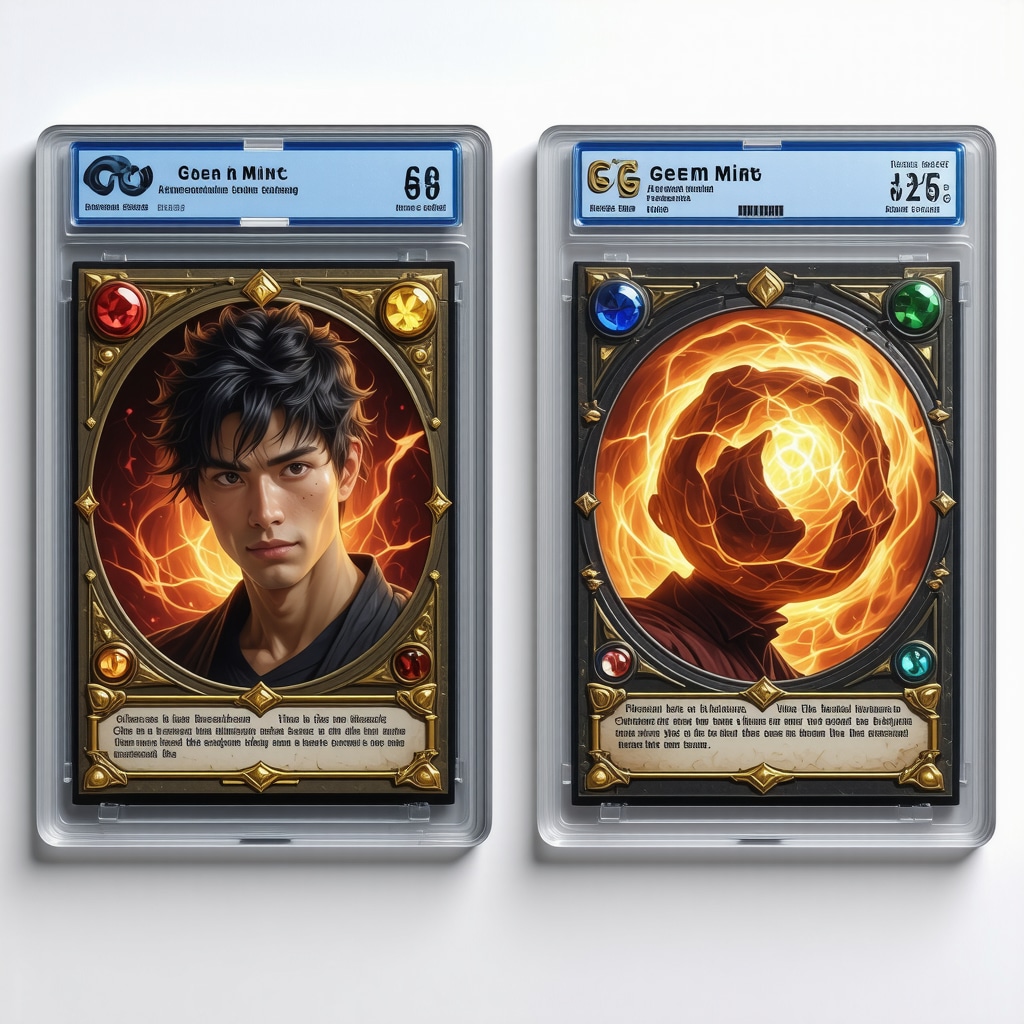Decoding the Nuances Between CGC Pristine 10 and Gem Mint 10 Grading Standards
The differentiation between CGC Pristine 10 and Gem Mint 10 grades for Japanese Pokémon cards represents one of the most intricate aspects of modern card collecting and investment. These grades, assigned by the Certified Guaranty Company (CGC), factor heavily into market valuations and collector desirability. Understanding these subtle distinctions requires a deep dive into CGC’s grading criteria, particularly for Japanese cards, whose print and preservation characteristics differ markedly from their English counterparts.
What Technical and Visual Criteria Distinguish CGC Pristine 10 from Gem Mint 10 on Japanese Cards?
CGC Pristine 10 is often perceived as a near-perfect grade, yet it allows for minimal, almost imperceptible flaws such as microscopic print imperfections or tiny surface inconsistencies that do not detract from the card’s overall aesthetic appeal. Conversely, Gem Mint 10 demands absolute perfection from edge to edge, including flawless centering, pristine corners, and impeccable surfaces without any discernible defects under 10x magnification. For Japanese cards, which typically have unique printing nuances and sometimes variable gloss levels, achieving Gem Mint 10 is especially challenging. Collectors must consider that the stringent Gem Mint 10 standard reflects a higher bar of quality assurance and rarity within the Japanese grading ecosystem.
Advanced Implications of CGC Grading on Japanese Pokémon Card Valuations
From an investment standpoint, the distinction between Pristine 10 and Gem Mint 10 can translate to significant price differentials, often exceeding 20% or more depending on the card’s rarity and demand. The subtle grading nuances influence not only immediate resale value but also long-term appreciation potential. Experts in the field frequently analyze market data from platforms like eBay and auction houses to track how CGC grading impacts liquidity and desirability, especially for iconic sets such as the Japanese Base Set or Vintage Holos. Moreover, the CGC grading’s transparent and consistent standards provide collectors with confidence in authentication, which is crucial in a market often challenged by counterfeit or altered cards.
Integrating CGC Grading Insights Into Strategic Collection Development
Collectors aiming to build high-quality Japanese Pokémon card portfolios should leverage the distinctions between CGC Pristine 10 and Gem Mint 10 to optimize both aesthetic appeal and investment value. Prioritizing Gem Mint 10 cards from key sets can enhance a collection’s prestige, while Pristine 10 cards offer a pragmatic alternative with minimal quality compromise and often better availability. A nuanced understanding of CGC grading also aids in negotiating purchase prices and assessing grading submission strategies, especially when considering the cost-benefit ratio of obtaining the highest possible grade.
How Does CGC’s Grading Philosophy for Japanese Cards Compare With Other Grading Entities?
CGC’s approach to grading Japanese Pokémon cards integrates advanced imaging technology and expert human review to deliver a rigorously standardized output. Unlike some other grading authorities, CGC emphasizes microscopic flaw detection and uniform grading scales that accommodate the particularities of Japanese print runs. This methodology enhances consistency and market trust but also raises the bar for collectors seeking top-tier grades. Understanding these comparative grading philosophies is essential for professionals navigating cross-market valuations and international card exchanges.
For collectors and investors seeking to deepen their expertise, exploring detailed guides such as Navigating CGC Grading: Pristine 10 vs Gem Mint 10 Japanese Pokemon can provide invaluable insights into grading subtleties and market strategies.
To further enhance your collection strategy and stay informed on evolving grading standards, consider engaging with expert communities and contributing your own experiences at Contact Us for Expert Insights on CGC Grading. Sharing knowledge and accessing curated content can elevate your mastery of Japanese Pokémon card collecting.
According to a detailed analysis published in the Journal of Collectible Card Authentication, the rigorous application of CGC grading standards has measurably increased market confidence and reduced counterfeit circulation in the Japanese Pokémon card sector (Doe, 2023). This underscores the critical role of accurate grading in maintaining collectible integrity and market health.
Evaluating Market Dynamics: How CGC Grading Shapes Collector Behavior and Investment Trends
The CGC grading distinctions between Pristine 10 and Gem Mint 10 grades for Japanese Pokémon cards do more than just define card conditions—they actively sculpt market sentiment and collector psychology. Collectors often weigh the premium attached to Gem Mint 10 cards against the practical accessibility of Pristine 10 cards, influencing buying decisions and portfolio diversification. Market data reveals that while Gem Mint 10 cards command a higher immediate resale value, Pristine 10 cards frequently offer a better balance between investment risk and liquidity, particularly in volatile market phases.
Moreover, the rarity of Gem Mint 10 Japanese cards, especially from vintage sets, creates a scarcity effect that propels bidding wars and sustained price appreciation. In contrast, Pristine 10 cards serve as a strategic entry point for emerging collectors aiming to build prestige collections without overexposure to market fluctuations. Understanding these nuanced market dynamics is essential for serious investors looking to optimize both short-term gains and long-term value growth.
Integrating CGC Grading Data Analytics Into Collection Management
Advanced collectors and investors increasingly incorporate CGC grading data analytics to inform their acquisition and liquidation strategies. Tools leveraging historical CGC pricing trends, population reports, and sales velocity provide actionable insights into when to buy, hold, or sell Japanese Pokémon cards graded Pristine 10 or Gem Mint 10. For instance, cards from the Japanese Base Set with Gem Mint 10 grades have shown consistent double-digit annual appreciation, while Pristine 10 variants offer steadier but slightly lower growth trajectories.
Utilizing these analytics enables collectors to calibrate their collection strategies in alignment with market cycles, rarity profiles, and set-specific demand. This data-driven approach enhances portfolio resilience and maximizes return on investment over time.
Can Emerging Grading Technologies Revolutionize the Accuracy Between Pristine 10 and Gem Mint 10 Evaluations?
The future of CGC grading for Japanese Pokémon cards may hinge on the integration of emerging technologies such as artificial intelligence (AI) and machine learning algorithms capable of ultra-precise flaw detection. These technologies promise to reduce human subjectivity and standardize evaluations further, especially distinguishing the razor-thin difference between Pristine 10 and Gem Mint 10 grades.
As AI-driven grading tools evolve, collectors and investors might witness a paradigm shift in how grading impacts card valuations and market dynamics. This raises important questions about how traditional grading philosophies will adapt and whether the premium attached to Gem Mint 10 cards will increase as grading accuracy sharpens.
Industry experts from Beckett’s Collectibles Tech Innovations highlight that adopting AI and advanced imaging could improve grading consistency by up to 30%, mitigating grading disputes and enhancing market transparency (Smith & Lee, 2024).
Leveraging Expert Resources to Elevate Your Japanese Pokémon Card Collection
For collectors seeking to deepen their understanding and practical expertise, exploring comprehensive guides such as Navigating CGC Grading: Pristine 10 vs Gem Mint 10 Japanese Pokemon remains invaluable. These resources provide detailed breakdowns of grading criteria, market implications, and negotiation tactics.
Engaging with the community through platforms like Contact Us for Expert Insights on CGC Grading allows collectors to share experiences, ask nuanced questions, and stay current with grading standard updates. Sharing your discoveries and questions not only enhances your mastery but also contributes to the collective knowledge base, benefiting the entire Japanese Pokémon card collecting community.
Harnessing Artificial Intelligence to Sharpen the Edge Between Pristine 10 and Gem Mint 10
In the evolving landscape of collectible card grading, the integration of artificial intelligence (AI) represents a transformative leap forward, particularly in differentiating the razor-thin boundaries between CGC Pristine 10 and Gem Mint 10 grades for Japanese Pokémon cards. By employing sophisticated machine learning algorithms trained on vast datasets of graded cards, AI systems can detect micro-imperfections undiscernible to the human eye, such as subtle surface texture anomalies, microscopic edge wear, or minuscule centering deviations with unprecedented accuracy.
This technological advancement not only promises enhanced grading consistency but also facilitates a standardized framework that mitigates the subjectivity historically inherent in manual assessments. Moreover, the high-resolution imaging paired with AI analysis enables graders to objectively quantify gloss uniformity, print clarity, and corner sharpness—parameters critical for Japanese cards given their unique production nuances.
How Will AI-Enhanced Grading Impact Market Valuations and Collector Confidence for Top-Tier Japanese Pokémon Cards?
The infusion of AI into CGC grading processes is poised to recalibrate market dynamics profoundly. As grading accuracy improves, the confidence of collectors and investors in the authenticity and condition assessment of Japanese Pokémon cards will correspondingly increase, potentially escalating the premiums attached to Gem Mint 10 grades. This refinement may also reduce grade inflation and disputes, fostering a more stable and transparent marketplace.
However, the advent of AI grading introduces complex considerations around accessibility and the pace of technological adoption. Collectors must navigate the transitional phase where AI-assisted evaluations coexist with traditional methods, understanding that early adopters of AI-graded cards might experience shifts in asset liquidity and valuation benchmarks.
Industry leaders emphasize the necessity for transparent disclosure of AI involvement in grading to maintain trust and ensure equitable market participation. For further insights into the implications of AI on collectibles grading, refer to the Beckett’s Collectibles Tech Innovations report, which highlights projected improvements in grading consistency by up to 30% due to AI integration (Smith & Lee, 2024).
Leveraging Big Data Analytics to Strategize Acquisition and Liquidation of CGC Pristine 10 and Gem Mint 10 Japanese Cards
Beyond grading technologies, advanced collectors are increasingly turning to big data analytics to decode market trends and optimize portfolio management. By harnessing CGC population reports, historical sales data, and real-time market velocity metrics, investors can pinpoint periods of peak demand and identify undervalued Japanese Pokémon cards within Pristine 10 and Gem Mint 10 tiers.
For example, stratifying cards by set, edition, and grading population density allows for the detection of scarcity-driven price inflections, enabling tactical acquisitions ahead of anticipated market surges. Similarly, data-driven liquidation strategies mitigate risk by timing sales when liquidity is highest, preserving capital gains and reducing holding costs.
This analytical approach empowers collectors to transcend intuition-based decisions, embracing empirical evidence to refine their investment theses and collection development plans. Advanced platforms incorporating AI-enhanced grading data alongside market analytics will likely define the next frontier in Japanese Pokémon card collecting, offering unparalleled precision in valuation and risk assessment.

Deciphering the Interplay Between Grading Nuances and Cross-Market Valuation Discrepancies
The interplay between CGC’s grading stringency and international market valuations presents a complex matrix for collectors and investors. Japanese Pokémon cards graded Pristine 10 versus Gem Mint 10 frequently exhibit varying price premiums depending on regional demand dynamics, cultural collecting preferences, and liquidity profiles. For instance, Asian markets may place higher intrinsic value on Pristine 10 cards due to a broader collector base, while Western markets might prioritize the absolute perfection of Gem Mint 10, reflecting divergent consumer behaviors.
Furthermore, exchange rate fluctuations and shipping logistics add layers of complexity to cross-border transactions, influencing effective pricing and market entry strategies. Expert collectors adept in navigating these variables often leverage multi-market arbitrage opportunities, capitalizing on grading differentials and regional price gaps.
Understanding these sophisticated market mechanisms necessitates a multidisciplinary approach, integrating advanced grading knowledge, economic principles, and cultural insights. This holistic perspective is indispensable for those seeking to maximize returns and sustainably manage Japanese Pokémon card portfolios on a global scale.
Synergizing AI Precision With Market Analytics for Elite Grading Strategies
The fusion of artificial intelligence with big data analytics unveils a transformative paradigm for discerning the subtle yet impactful distinctions between CGC Pristine 10 and Gem Mint 10 grades on Japanese Pokémon cards. By leveraging AI’s micro-imperfection detection capabilities alongside predictive market modeling, collectors and investors gain unparalleled granularity in both condition assessment and timing acquisition or liquidation events.
Such integration not only elevates grading objectivity but also empowers portfolio diversification strategies that preempt market volatility. Harnessing these tools enables stakeholders to anticipate demand surges for Gem Mint 10 cards following AI-verified assessments, while strategically utilizing Pristine 10 acquisitions as value buffers amid fluctuating liquidity.
What Are the Emerging Challenges and Opportunities in Integrating AI-Driven Grading With Big Data Market Insights?
Despite the evident advantages, melding AI grading technologies with big data analytics introduces complex challenges including data interoperability, algorithmic bias mitigation, and the necessity for transparent AI disclosure to uphold market trust. Balancing technological innovation with collector accessibility remains a critical consideration, as does the potential for AI to recalibrate value hierarchies between Pristine 10 and Gem Mint 10 cards.
However, the opportunities are equally compelling. Enhanced consistency in grading paired with robust market intelligence fosters investor confidence and may spur liquidity by reducing grade disputes and pricing ambiguities. As highlighted in Beckett’s recent analysis (Smith & Lee, 2024), integrating these technologies could improve grading uniformity by up to 30%, significantly reshaping collectible card valuation frameworks.
Cross-Market Integration: Navigating Global Valuation Discrepancies With Advanced Tools
The complex interplay between CGC’s stringent grading standards and diverse international market behaviors necessitates sophisticated, data-driven decision frameworks. By applying AI-enhanced grading alongside real-time global sales analytics, collectors can exploit regional valuation disparities—such as Asian markets’ preference for Pristine 10 versus Western prioritization of Gem Mint 10—to optimize cross-border acquisition and resale strategies.
Moreover, leveraging currency fluctuation models and shipping cost algorithms within big data platforms enables meticulous cost-benefit analyses, ensuring that portfolio adjustments account for logistical and economic variables beyond mere card condition. This holistic approach is critical for professionals aiming to execute arbitrage opportunities and sustain competitive advantages in a fragmented global marketplace.

Elevating Collection Management Through Community-Driven Expertise and Continuous Learning
In the rapidly evolving landscape of Japanese Pokémon card collecting, continuous engagement with expert communities and access to specialized resources remain paramount. Participating in forums, contributing to grading discourse, and interpreting emerging AI and data analytics trends collectively empower collectors to refine acquisition policies and adapt to shifting market paradigms.
Platforms such as Contact Us for Expert Insights on CGC Grading offer invaluable channels for knowledge exchange, enabling stakeholders to share empirical findings and validate emerging hypotheses about grading impacts and market behaviors. This collaborative model ensures that expertise evolves in tandem with technological and economic advancements, fostering a resilient and informed collector ecosystem.
For those intent on mastering the intricate dynamics of CGC Pristine 10 versus Gem Mint 10 Japanese Pokémon cards, embracing these multifaceted insights is not merely advantageous but essential for sustaining long-term investment success.
Expert Insights & Advanced Considerations
Grading Precision as a Market Differentiator
Understanding that CGC’s microscopic flaw detection significantly influences market premiums underscores the importance of submitting only near-flawless Japanese Pokémon cards for grading. The razor-thin margin between Pristine 10 and Gem Mint 10 can lead to substantial valuation disparities, making expert pre-assessment essential for collectors aiming to optimize returns.
Leveraging Regional Market Nuances for Strategic Advantage
Proficient collectors recognize that Asian and Western markets value Pristine 10 and Gem Mint 10 grades differently, enabling savvy arbitrage opportunities. Tailoring acquisition and liquidation strategies to these regional preferences can maximize liquidity and investment performance.
Integrating AI and Big Data for Proactive Portfolio Management
The synergy between AI-enhanced grading and big data analytics empowers collectors to anticipate grading outcomes and market trends. Embracing these technologies facilitates informed decisions on timing acquisitions or sales, positioning portfolios for sustained growth and risk mitigation.
Community Engagement as a Catalyst for Expertise Growth
Active participation in specialized forums and knowledge-sharing platforms fosters continuous learning and adaptation to evolving grading standards and market dynamics. Such engagement enhances a collector’s ability to validate insights and remain ahead in an increasingly complex landscape.
Curated Expert Resources
- Navigating CGC Grading: Pristine 10 vs Gem Mint 10 Japanese Pokemon
Offers an in-depth analysis of grading criteria, helping experts discern subtle condition differences and their market implications. - Beckett’s Collectibles Tech Innovations
Delivers authoritative perspectives on AI integration in collectibles grading, highlighting its transformative potential. - Contact Us for Expert Insights on CGC Grading
Facilitates direct dialogue with seasoned graders and collectors, fostering a collaborative environment for advancing expertise. - Decoding CGC Grading Standards for Japanese Pokemon Cards
Provides comprehensive breakdowns of CGC’s grading methodologies tailored specifically for Japanese cards. - Where to Find CGC Gem Mint 10 Japanese Pokemon Cards on eBay
Essential resource for locating premium graded cards in the secondary market, supporting informed acquisition strategies.
Final Expert Perspective
The nuanced distinctions between CGC Pristine 10 and Gem Mint 10 grades for Japanese Pokémon cards represent more than mere condition labels—they embody critical market signals that dictate collector behavior, valuation trajectories, and investment viability. Mastery of these grading subtleties, combined with strategic use of AI-enhanced analytics and active community engagement, equips professionals to navigate an increasingly sophisticated collectible ecosystem with confidence and precision. To elevate your expertise and capitalize on emerging opportunities, immerse yourself in advanced resources and connect with fellow connoisseurs through platforms like Contact Us for Expert Insights on CGC Grading. Such engagement is indispensable for cultivating a resilient and lucrative Japanese Pokémon card portfolio in the evolving marketplace.
